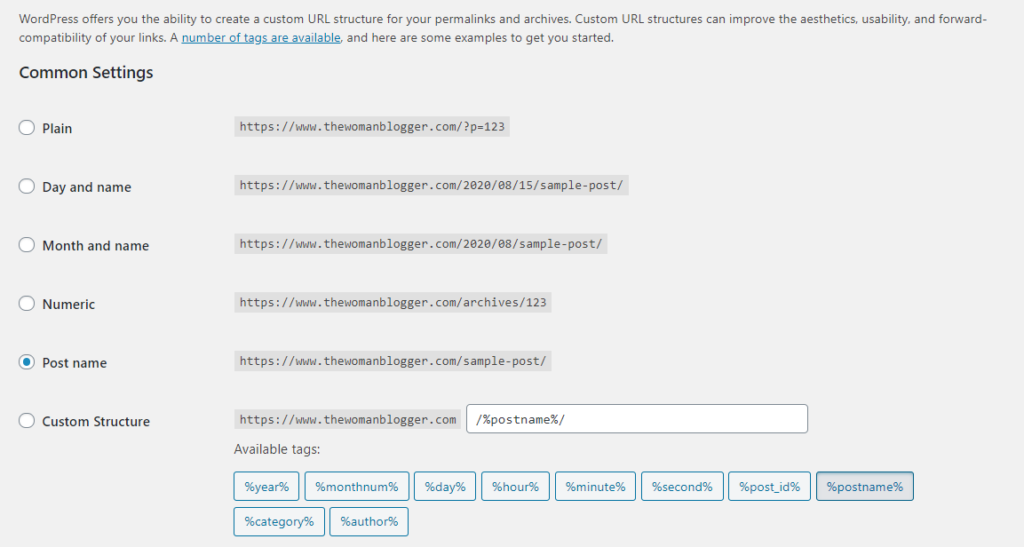What is WordPress Permalink Structure?
Your WordPress URL is your website’s digital address. Your permalink structure the part of your URL that comes after the first forward slash.
Your URL:
Your URL with Permalink:
https://thewomanblogger.com/change-wordpress-permalink-structure/
Noticed the permalink in the above-mentioned URL is the keyword I’m using for this blog post to rank on Google?
When you start your WordPress website your default permalink looks something like this:
https://www.thewomanblogger.com/?p=123While this does work it’s not a very SEO friendly permalink structure.
WordPress Permalink Structures
WordPress has a few options for you when it comes to permalink structures.

1. Plain
https://www.thewomanblogger.com/?p=123This is the WordPress default permalink structure and the most SEO UNFRIENDLY of all. It just adds a post number at the end of your URL. This is the number used to save your post in the database at the WordPress backend of your website. As soon as you launch your website get rid of this structure before publishing your posts.
2. Day and Name and Month and Date
https://www.thewomanblogger.com/2020/08/15/sample-post/
https://thewomanblogger.com/2020/08/sample-post/ The two options following the plain permalink structure are used when you want to include the publishing date in your URL.
Most blog owners generally create evergreen content. If this is you, the date and time is the last thing you need in your permalink.
Adding a date will only make your future readers deviate from your content because no one wants to read a piece of article that is 3 years old even when it is still as useful as when it was first published.
On the contrary, if you are a news website or your content is viral in the sense it will no longer be meaningful after a short period of time, you can make use of this permalink structure. Bear in mind the change reflects on all of your posts.
3. Numeric
https://www.thewomanblogger.com/archives/123Again a numeric permalink structure is hard to read for humans as well as your SEO bots. It doesn’t reflect what the content is about. Therefore, it is bad for your SEO.
4. Post Name
https://www.thewomanblogger.com/sample-post/This is what you are looking for. The post name structure adds the title of your post to your permalink separated by a hyphen (dash) in place of space. This is readable for humans as well as Google SEO bots.
The only catch is you need to cut out stop words from this title before you hit publish. Stop words are words like ‘to’, ‘and’, ‘the’ et Cetra. They are generally not useful for SEO and so should not be a part of your post’s URL.
The best practice is to edit your permalink to fit in your most relevant keyword for best SEO results. More on how to edit your permalink structure in Gutenberg in the next section.
5. Custom Structure
You have the liberty to create custom URLs in WordPress. These can include various tags, category slugs, authors, et cetera. Although, you might find them useful, but from the SEO perspective they should be avoided as they make your URLs long.
Longer URLs don’t even get read to their length. Keep your URLs short and meaningful within a 50 to 60 character mark.
6. Optional
You can further change the permalink structure for your category and tag URLs.

How to Change your Permalink Structure?
To change your permalink structure go to your WordPress Dashboard >> Settings >> Permalinks >> Choose your desired permalink structure >> Save.

How to change URLs for a Single Post?
Even after selecting the Post Name type permalink structure you still might want to change your post URL to emit stop words or place your target keyword in the URL.
By default your URL might look something like:
https://www.thewomanblogger.com/how-to-change-permalink-structure-on-wordpress-to-improve-seo/You can simply change it to suit you better like this:
https://www.thewomanblogger.com/change-wordpress-permalink-structures/To change the URL of a single post you need to edit your post.
Place the title of your post and save the draft. Once saved you can click on the post title in your Gutenberg page builder to edit the permalink.

WARNING! for Already Established Blogs/Websites
If you already have an established website that is older than 6 months and you have content that has been shared on Social Media/other websites, you might reconsider changing your permalink structure.
Changing the URL structure now will reflect on all your previous posts as well as your upcoming future posts. This will change the URL you used to share your post on other websites and platforms.
If you still have to do it, get it done by someone who knows how to properly redirect your previous URLs to new URLs, or follow this method:
How to Redirect your URLs to avoid 404s?
To redirect your previous URLs to your new URLs you will need to redirect them. Otherwise, all the posts you shared on Social Media or other websites will return 404 Page Not Found errors. You will lose a lot of traffic this way.
Go to Plugins.
Add New Plugin.
Search for Redirection Plugin.
Install the first in the list.

You can then simply add your URL redirects after a simple plugin setup in the Redirection Plugin.
Here is an example:

That’s it about how to change permalink structure on WordPress website/blog. If you have any questions leave them in the comments area below.
Related: Blog Post SEO Checklist you must know
Pin it for later!





